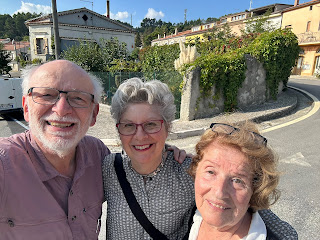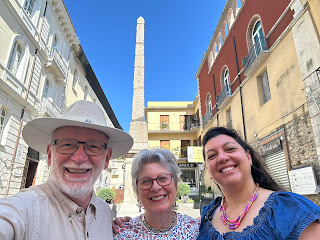 |
| Maria, Dante with their homemade meatballs and peas |
"Be careful," warned my friend Maria. "There are wild boars roaming around."
My husband,Tom, and I have made many memories traveling around Southern Italy's rural Campania region.
Perhaps this time, we'd make another.
As it turned out, we encountered no boars, but we did run into a flock of sheep blocking both sides of a two-lane road leading to Greci, a hill town between Bari and Naples, where my grandfather was born.
 |
| Sheep in the road on the way to Greci |
Maria and her husband, Dante, live in nearby Ariano Irpino. We met 13 years ago on our first visit to Greci. Maria's mother was born there, and Maria, who lived for a while in England, speaks fluent English.
After touring Greci, we enjoyed a memorable meal at their home, including prosciutto from the recently-slaughtered family pig. We met again a few years ago, this time while we were exploring more of Southern Italy with my husband's brother, Al, and his wife, Nancy.
Al mopped up Maria's sauce with his bread, a gesture for which Dante bestowed on him the title of "Buona Forchetta," or Beautiful Fork, roughly translated "Good Eater."
It's been our good fortune to have stayed in touch with Maria and Dante and others in Italy whom we've met over the years during family visits (Tom's family is from Southern Italy and Sicily) and through story assignments for the Seattle Times and other publications.
When the Covid pandemic ended and we had a chance to travel again, I stole an idea from another journalist whom I admire: Pick destinations where you know people, and make plans to reconnect.
On this trip, a return to our favorite big city in Italy - Naples - and a desire to see something new - Lecce, a Baroque jewel box in southern Puglia - were the jumping off points for visits with several sets of old friends. A bonus was detouring through or staying in towns tourists rarely find a reason to visit.
Navigating our way around the sheep in a rental car was nerve-wracking, but worth it considering the reason we were on this back road was because we had detoured through the tiny town of San Marco dei Cavoti, the center of torrone production (nougat candy) in Southern Italy. We stopped at a century-old shop for vintage boxes of torrone baci (chocolate nougat), then found a bakery with a few tables on a shady patio. The warm weather called for sampling our new favorite coffee drink - crema di caffe - an icy, whipped concoction of espresso, cream and sugar eaten with a spoon.
 |
| Crema di Caffe in San Marco |
Waiting for us in Greci was Rita DiMinno, the town's unofficial ambassador to American visitors, many of whom are members of an online group called Greci Cousins. Rita was born in Greci but moved to Australia with her family as a young girl after her father, a shoemaker, found work there. Rita learned English, and returned to Greci for a visit. There she met, and later married her late husband, Pino Perillo.
 |
| Rita in her kitchen with her homemade tiramisu served with a shot of Strega, an herbal liquer from the nearby town of Benevento. |
Greci's history is unique because it is one of 51 Italian towns settled by Albanians between the 15th and 18th centuries. The communities call themselves "Arbereshe,'' and the people in these towns speak an Albanian dialect as well as Italian.
Albanian soldiers settled in Greci sometime in the mid-1400s when the King of Naples invited them to relocate after the military leader, Skanderbeg, answered a call to help the Italians defeat French-supported insurrections.
 |
| A new monument in Greci honors the Albanian war hero Skanderbeg |
Nearly 4000 people lived in Greci in the 1950s. Now there are only about 450, most of them retired. But things are looking up as more people from Naples make their summer homes here. After a slice of her homemade tiramisu, Rita took us on a walk around town to show us what was new including a new monument dedicated to Skanderbeg, a new restaurant (the only one in town) and several bed and breakfasts in addition to a caffe/bar and a doctor who makes house calls.
 |
| The new restaurant in Greci is called Ha e Pi, Arbëresh for Eat and Drink. |
 |
| Rita, Tom and me in front of her home in Greci |
 |
| Together again with Dante and Maria |
After our walk with Rita, we had dinner once again with Maria and Dante in Ariano. They fixed a pasta with homemade tomato sauce and a traditional dish of homegrown peas and meatballs, followed by fresh figs from their tree. They didn't kill a pig this year, so no prosciutto. Maybe next year, they said, if they can get some help. I see a return visit in our future.
 |
| Sant'Agata dei Goti |
Sant' Agata dei Goti
Our next stop was
Sant' Agata dei Goti, an ancient town built on a rock cliff above a river in an area called the Sannio, off-the-radar compared to Tuscany in the north, but an abundant agricultural area known for its wine.
 |
| Sant' Agata historical center |
In 2008, while searching for a place to stay, we found
Sentieri Luminosi, a recently opened bed and breakfast. Our hosts were Loredana Fusaro, then a cook at a local restaurant and massage therapist, and her husband, Enrico Pofi, a photographer. They moved here from Naples, and bought a 19th-century stone building on a bluff overlooking the town. We were their first non-Italian guests, and since they both spoke some English, we got to know each other. I wrote a story about the Sannio which included a mention of Sentieri Luminosi, and a picture of Loredana and Enrico in their yard surrounded by fig trees.
Fast forward to 2023. Enrico and I connected on Facebook. Yes, they remembered us, and would be happy to meet. We set a time and date for a rendezvous in town for a drink, then they generously invited us back to their home for lunch. A few minutes in the kitchen, and Loredana had assembled a meal of pasta, local cheeses, salami, olives, cooked greens, bread and wine.
 |
| Lunch with Enrico and Loredana |
We talked and ate at the same table where we had breakfast 15 years ago. Loredana went into her file drawer and pulled out a copy of the story I had written which she had saved all these years. It was one of those moments that we all hope for when we travel, a time when we no longer feel like tourists, but friends.
 |
| The Arch of Trajan |
Benevento
Our base for exploring Campania was
Benevento, a mid-sized city about 30 miles northeast of Naples. Reminders that it once flourished as a Roman colony include a restored Roman theater, an archeological park and an arch at the entrance of the town, built in 114, considered to be among the best-preserved Roman structures in Campania.
 |
| Shop selling all things Strega |
Benevento became famous for two things: witches and Strega, a powerful greenish-yellow herbal liqueur, served and sold everywhere as a drink and in chocolate candies and torrone. Thirteenth-century folklore spread the belief that Benevento would be a gathering place for Italian witches. Many famous writers, musicians and artists wove tales of witches into their works, taking inspiration from the Benevento legend.
Strega takes its name from the legend of the streghe (Italian for witches). its label depicts the streghe dancing under a walnut tree.
 |
| Strega includes 70 herbal ingredients include saffron |
Benevento's main street is pedestrianized with side streets leading to hidden restaurants and cafes. There's a Sunday flea market and a lively early-evening passegiatta when friends and families meet for a stroll, a drink or last-minute shopping before the stores close. Some years ago, while staying at a B&B in Tbilisi, Georgia, we met Gianna Fusco, an Italian professor whose home town was Benevento.
We stayed in touch, and met up a few years ago in Naples where Gianna was teaching. When she saw on Facebook that we were again in Italy, she got in touch. Although she now lives in L'Aquila where she teaches American literature and American studies, she drove to Benevento to meet us. We owe her mother a big thank you for a bottle of the homemade limoncello she sent our way, and Giana an invitation to come visit in Seattle.
 |
| Tom, Gianna and I in Benevento. The obelisk in the background was originally erected for the Roman Temple of Isis. Heroglyphs appear on four sides |
Last stop: Rome
Rome has been so inundated with tourists, we had decided not to stop, and instead take a train directly from Benevento to the airport to catch a flight to Reykjavik, Iceland. We changed our mind when we found out our old friend, Letizia Mattiacci, had relocated there after selling her bed and breakfast inn in Assisi.
 |
| Letizia and us in Rome |
It was 20 years ago, that we found Agriturismo Alla Madonna del Piatto five miles off the main highway above Assisi in the central Italy.
Letizia and her Dutch husband, Ruurd de Jong, gave up careers as entomologists to buy and renovate the abandoned farmhouse built centuries ago as a refuge for shepherds.
With six cozy rooms, breakfast and dinner, Alla Madonna made an ideal base for visiting the medieval villages of Umbria, and since Letizia offered cooking classes, we were able to take advantage of a rainy afternoon to trade in a few hours of sightseeing for the chance to tinker in an Italian kitchen.
It was a memorable experience that made its way into a story for The Times. Letizia, like Loredana in Sant' Agata, had saved a copy of the print version that included a picture of her.
After two years of dealing with a difficult family situation, Letizia, the author of two cookbooks, has reinvented herself in Rome. We met for a drink in her new neighborhood, Appio Latino, a short Metro ride from the historical center. She has launched a new business -
Madonna del Piatto - and restarted cooking classes. Instead of a farmhouse, students will find themselves in an authentic Roman neighborhood devoid of tourists. There they will spend several rewarding hours cooking in Letizia's kitchen, then sharing a four-course lunch in her dining room.
 |
| Hosteria L'Orso 80 |
Our visit with Letizia was worth detouring to Rome for one night, but I wasn't sorry we weren't staying on. The crowds were getting on my nerves as we walked in a human traffic jam past the Trevi Fountain to a restaurant near the Piazza Navona that's always been a favorite.
I reluctantly made reservations, expecting it to be flooded with tourists and service to be rushed. But as we got closer, the crowds seemed to disappear, and there, on a quiet street, was
Hosteria L'Orso 80, mostly as we remembered it.
The warm weather meant we could sit on the patio. We ordered what we always order - the antipasti della casa -- more than a dozen bowls filled with roasted eggplant, zucchini, peppers, prosciutto, salami, cheeses, salads, melon and meatballs.
The price has gone up a bit since we first visited years ago, but not much else has changed. A man still sits at a vintage cashier's desk inside tallying up the bills. Sometimes the waiter will throw in an extra meatball.
After a week spent reconnecting with Italian friends, D'Orso felt like an old friend too.


















What a lovely post. I have family ties to Greci and Ariano Irpino so it was neat to see someone writing about it.
ReplyDelete